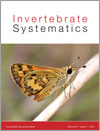The taxonomy of the Taractrocera ilia complex is revised based on evidence from multiple sources, including phenotypic characters (wing colour pattern elements, morphology of adult and immature stages), ecology and molecular data. Three species are recognised in the complex: T. psammopetra Braby, sp. nov. is restricted to north-western Australia where it has a disjunct distribution (Kimberley and the central Arnhem Land plateau); T. ilia (Waterhouse, 1932) sensu stricto is endemic to the central Arnhem Land plateau where it is narrowly sympatric with T. psammopetra; while T. beta Evans, 1934, stat. nov. is allopatric and endemic to mainland New Guinea. Each species is illustrated and diagnosed based on comparative morphology of the adult stage, including androconia and male and female genitalia, and information on type material, biology, distribution and habitat is summarised and discussed. A phylogenetic hypothesis of the Australian species of Taractrocera based on combined analysis of molecular data (2.6 kb: mitochondrial COI and nuclear CAD, MDH, wingless) revealed that T. psammopetra is monophyletic and sister to T. ilia, with an overall mean divergence of 3.4% between the two species; the genus Taractrocera, however, emerged as polyphyletic. For T. psammopetra and T. ilia, the life history, including details of larval food plant specialisation and morphology of the immature stages, is described for the first time. Larvae of T. psammopetra and T. ilia specialise on ‘resurrection’ grasses, Micraira spp. (Poaceae), which typically grow as moss-like, mat-forming pioneer plants on shallow rock surfaces comprising open sandstone pavements or on rock ledges and under rock overhangs of sandstone cliffs. These food plants, together with the butterflies that they support, are a characteristic element of the sandstone plateaux of the Kimberley and central Arnhem Land, and they exemplify patterns of diversification, endemism and adaptation to these unique environments within the Australian monsoon tropics. Facultative larval diapause is recorded for both T. psammopetra and T. ilia in which larvae (all instars, but particularly the final instar) may suspend feeding for up to six months during the dry season when the food plants typically dehydrate. It is hypothesised that larval diapause may be the most flexible strategy to ameliorate seasonal adversity of the dry season and the onset, duration and inter-annual cycle of monsoon rainfall during the wet season, which is highly variable and unpredictable, given that Micraira can revive rapidly from a desiccated state after rainfall.
How to translate text using browser tools
30 October 2015
Taxonomic revision of the Taractrocera ilia (Waterhouse) complex (Lepidoptera : Hesperiidae) from north-western Australia and mainland New Guinea based on morphological and molecular data
Michael F. Braby,
Andreas Zwick
ACCESS THE FULL ARTICLE
<
Previous Article
|

Invertebrate Systematics
Vol. 29 • No. 5
October 2015
Vol. 29 • No. 5
October 2015
general lineage concept
Hesperiinae
resurrection plants
skipper butterfly
Taractrocerini
Wallacea




